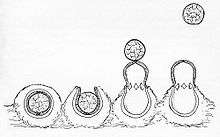Sphaerobolus
Sphaerobolus is a genus of fungi in the family Geastraceae. Commonly known as the "shotgun fungus" or "cannonball fungus", species discharge their spores with explosive force. Discharged spore sacs are sticky and have a tendency to strongly adhere to whatever surface they encounter, making them a nuisance to homeowners, pressure washing contractors, landscape mulch producers and insurance companies.[1][2]
| Sphaerobolus | |
|---|---|
 | |
| Sphaerobolus stellatus | |
| Scientific classification | |
| Kingdom: | |
| Phylum: | |
| Class: | |
| Subclass: | |
| Order: | |
| Family: | |
| Genus: | Sphaerobolus Tode (1790) |
| Species | |
|
Geml, D.D. Davis & Geiser (2005) S. stellatus Tode (1790) | |

Taxonomy and classification
The generic name is derived from the Greek words sphaer, meaning "sphere", and obolus, meaning "to throw". Sphaerobolus was first described by the Italian priest and biologist Pier Antonio Micheli (as Carpobolus) in 1729.[3] Formerly, the genus was placed either in its own family, the Sphaerobolaceae, in the order Sclerodermatales,[4] or, more commonly, in the order Nidulariales.[5][6] Currently, the genus is placed in the family Geastraceae.[7]
Recent phylogenetic analysis suggests that Sphaerobolus should be placed in the gomphoid-phalloid clade along with related genera like Geastrum, Phallus, Pseudocolus, Ramaria, Clavariadelphus, Gomphus and Gautieria.[8][9] Within the genus, three highly supported clades may be discerned, corresponding to S. stellatus, S. iowensis, and the recently described taxon S. ingoldii.[10][11]
Description
Fruiting bodies, which grow in groups, are 1–3 mm in diameter, roughly spherical or ovoid in shape, and white to buff in color. The peridium (outer wall) consists of several layers, including a gelatinous layer. At maturity, the exoperidium (outermost layer) splits into several lobes to expose the dark brown, single peridiole (spore casing). The peridiole is forcibly ejected (sometimes up to several feet), leaving an evaginated endoperidium. Spores are typically 6–10 x 4–6 μm, elliptical to oblong in shape, thick-walled, and hyaline. Species have a cosmopolitan distribution,[11] and are usually found on dung, decaying wood (such as landscaping mulch), or vegetative litter.[5]
Mechanism of spore discharge
The peridium, which consists of six distinct layers, forms two "cups" at maturity.[12] Three layers form the outer cup, two form the inner cup, and one layer dissolves to create the fluid that bathes the gleba.[13] After splitting of the peridal layers to expose the gleba, enzymatic conversion of glycogen to glucose increases the internal osmotic pressure and the turgidity of palisade cells in the inner peridial cup.[14][15] Analysis of the glebal carbohydrates revealed an increase in glucose, mannitol, and trehalose prior to glebal discharge, which would account for the increase in osmotic pressure.[16] Glebal discharge typically occurs 5–6 hours after the apex has split.[17] In S. stellatus, the gleba may be thrown up to 6 meters horizontally.[18][19] This species is phototropic, and the nearest source of direct or reflected light will be the target for glebal discharge.[17]
Species
- Sphaerobolus ingoldii
- Sphaerobolus iowensis
- Sphaerobolus stellatus
References
- Lehman R (1985). "Black spots on houses—an insect or disease problem?". Penn Dept Agric Bur Pl Ind, Reg Hort. 11: 15–16.
- Brantley EA, Davis DD, Kuhns L (2001). "Biological control of the artillery fungus, Sphaerobolus stellatus, with Trichoderma harzianum and Bacillus subtilis"". Journal of Environmental Horticulture. 19: 21–23.
- Micheli PA. (1729). in Nova Plantarum Genera. Florence, Italy.
- Kendrick, Bryce (2001). The Fifth Kingdom. Focus Publishing / R. Pullins & Co. ISBN 1-58510-022-6.
- Miller HR, Miller OK (1988). Gasteromycetes: morphological and developmental features, with keys to the orders, families, and genera. Eureka, Calif: Mad River Press. ISBN 0-916422-74-7.
- Aguirre Acosta E, Ulloa M, Hanlin RT, Aguilar S (2000). Illustrated dictionary of mycology. St. Paul, Minn: APS Press. ISBN 0-89054-257-0.
- Bisby GR, Ainsworth GC, Kirk PM, Aptroot A (2001). Ainsworth & Bisby's Dictionary of the fungi / by P. M. Kirk... [et al.]; with the assistance of A. Aptroot... [et al.] Oxon: CAB International. ISBN 0-85199-377-X.
- Hibbett DS, Pine EM, Langer E, Langer G, Donoghue MJ (1997). "Evolution of gilled mushrooms and puffballs inferred from ribosomal DNA sequences". Proc. Natl. Acad. Sci. U.S.A. 94 (22): 12002–6. doi:10.1073/pnas.94.22.12002. PMC 23683. PMID 9342352.
- Moncalvo JM, Vilgalys R, Redhead SA, Johnson JE, James TY, Catherine Aime M, Hofstetter V, Verduin SJ, Larsson E, Baroni TJ, Greg Thorn R, Jacobsson S, Clémençon H, Miller OK (June 2002). "One hundred and seventeen clades of euagarics". Mol. Phylogenet. Evol. 23 (3): 357–400. doi:10.1016/S1055-7903(02)00027-1. PMID 12099793.
- Geml J, Davis DD, Geiser DM (2005). "Phylogenetic analyses reveal deeply divergent species lineages in the genus Sphaerobolus (Phallales: Basidiomycota)". Molecular Phylogenetics and Evolution. 35 (2): 313–22. doi:10.1016/j.ympev.2005.01.014. PMID 15804406.
- Geml J, Davis DD, Geiser DM (2005). "Systematics of the genus Sphaerobolus based on molecular and morphological data, with the description of Sphaerobolus ingoldii sp. nov". Mycologia. 97 (3): 680–94. doi:10.3852/mycologia.97.3.680. PMID 16392256.
- Buller AHR. (1933). Researches on Fungi, vol. 5. Longmans, Green and Co., London.
- Ingold G (1972). "Sphaerobolus: the story of a fungus". Transactions of the British Mycological Society. 58 (2): 179–195. doi:10.1016/S0007-1536(72)80147-5.
- Walker LB, Anderson E (1925). "Relation of glycogen to spore-ejection". Mycologia. 17 (4): 154–159. doi:10.2307/3753786. JSTOR 3753786.
- Fiegler S (1982). "A scanning ultrastructural histochemical procedure for localization of polysaccharide". Mycologia. 74 (2): 348–351. doi:10.2307/3792909. JSTOR 3792909.
- Fletcher M, Cooke R (1984). "Carbohydrate changes in the developing sporophore of Sphaerobolus stellatus". Transactions of the British Mycological Society. 82 (2): 366–369. doi:10.1016/S0007-1536(84)80088-1.
- Nawaz M (1967). "Phototropism in Sphaerobolus". Biologia. 13: 5–14.
- Walker L (1927). "Development and mechanism of discharge in Sphaerobolus iowensis and S. stellatus Tode". J. Eli. Mitch. Sci. Soc. 42: 151–178.
- S. M. Douglas. "Sphaerobolus spp.—The Artillery Fungus" (PDF). The Connecticut Agricultural Experiment Station. Retrieved 2008-11-27.
External links
- Tom Volk's Fungus of the Month, July 2005
- Sphaerobolus stellatus--The Artillery Fungus
- "Sphaerobolus Tode". Atlas of Living Australia.